7 Tips for Streamlining Your Accounts Payable Process

As a business owner, you probably have regular expenses, whether from vendors, suppliers, or other business relationships.
Accounts payable (AP) is the term for such debts. Typically, these are short-term liabilities for goods you’ve already received but not yet paid for.
Though AP is a standard part of business, it doesn’t always get top priority. Yet neglecting it can hurt your business relationships and, ultimately, your bottom line.
To ensure this doesn’t happen, try to streamline your AP process by doing the following:
- Evaluate your current AP process
The first step to improving AP is to evaluate your current process. Are you getting electronic or paper invoices? Are you entering data manually? Are you getting invoices paid on time?
Map out your entire AP process to identify potential bottlenecks, redundancies, and other gaps. You may find areas where you can save time by doing it another way.
- Standardize the AP process
Standardize your AP process from start to finish. This includes invoice entry, receipt, management, approval, and payment.
For example, instead of having invoices sent to different departments, have them sent to a central location. This way, you don’t have invoices floating all over the place.
Ensure suppliers know exactly where to send their invoices and that the procurement team knows what to do with them. Don’t forget to prioritize invoices by due dates.
The key to a more efficient AP process is to keep it simple and delegate tasks and responsibilities in a logical way.
- Accept electronic invoices
Paper invoices are becoming a thing of the past. If you are still getting them, consider asking vendors to switch to electronic invoices. These are much easier to manage, require fewer touchpoints, and save a lot of time in the long run.
- Decide when and how to pay invoices
There are a few different ways you can go about paying invoices. You can batch them according to their due dates and pay multiple at the same time, or you can pick certain days of the month when you pay all outstanding invoices, such as the 1st and 15th of the month. The point is to stick to a consistent method.
As for how to pay invoices, you have a few options. You can pay via electronic transfer (ACH or wire) or a check in the mail. Electronic payment methods are usually faster and preferred by vendors.
- Use AP automation software
Another way to level up your AP process is to invest in accounts payable automation software. As your business grows, you may find it harder and harder to keep track of everything—including invoices.
Automation software can help track them for you, organize them, expedite payment authorizations, and alert you to red flags (such as incorrect charges and other discrepancies).
This way, you can eliminate the need for manual data entry, avoid costly mistakes, and free up staff to work on more important business tasks.
- Track key AP metrics
Peter Drucker once said, “You can’t improve what you don’t measure.” And the same goes for your AP workflow.
So start tracking key performance metrics such as the total number of invoices received, the total number of invoices processed, the rate of incorrect payments, the average time to payment, the number of discounts captured, and the average cost per invoice.
Run regular reports to see how things are going and identify areas to improve.
- Archive AP data
Lastly, an important part of keeping good financial records is saving AP records. This creates a digital paper trail that you can reference later on for tax and other purposes.
Store AP files locally and on the cloud for added protection against data loss.
Final thoughts
Ultimately, every business is made up of many processes that must work together for it to succeed. Accounts payable is one of them. Don’t neglect it and your business will be better off for it.



